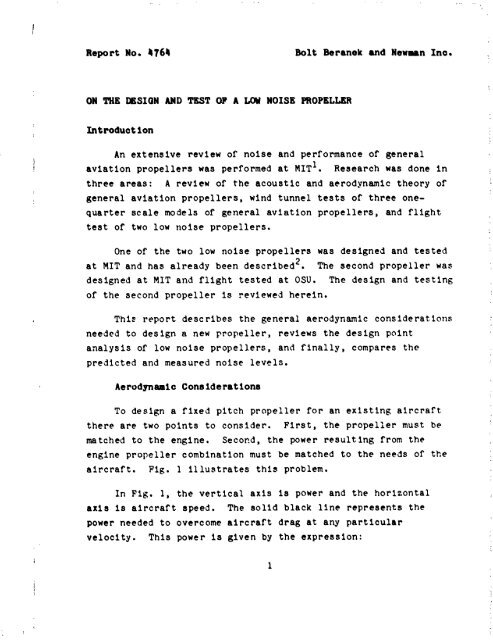On the Design and Test of a Low Noise Propeller - CAFE Foundation
On the Design and Test of a Low Noise Propeller - CAFE Foundation
On the Design and Test of a Low Noise Propeller - CAFE Foundation
You also want an ePaper? Increase the reach of your titles
YUMPU automatically turns print PDFs into web optimized ePapers that Google loves.
Report No. 1761Bolt Beranek <strong>and</strong> Newman Ino.ON THE mSION AND TEST OF A LOW NOISE PROPELLERAn extensive review <strong>of</strong> noise <strong>and</strong> performance <strong>of</strong> generalaviation propellers was performed at MIT" Research was done inthree areas: A review <strong>of</strong> <strong>the</strong> acoustic <strong>and</strong> aerodynamic <strong>the</strong>ory <strong>of</strong>general aviation propellers, wind tunnel tests <strong>of</strong> three onequarterscale models <strong>of</strong> general aviation propellers, <strong>and</strong> flight.test <strong>of</strong> two low noise propellers.<strong>On</strong>e <strong>of</strong> <strong>the</strong> two low noise propellers was designed <strong>and</strong> testedat MIT <strong>and</strong> has already been described2. The second propeller wasdesigned at MIT <strong>and</strong> flight tested at OSU. The design <strong>and</strong> testing<strong>of</strong> <strong>the</strong> second propeller is reviewed herein.This rpport deac ribes <strong>the</strong> general aerodynamic considerat ionsneeded to design 8 new propeller, reviews <strong>the</strong> design point.analysis <strong>of</strong> low noise propellers, <strong>and</strong> finally, compares <strong>the</strong>predicted <strong>and</strong> measured noise levels.To design a fixed pitch propeller for an existing aircraft<strong>the</strong>re are two points to consider. First, <strong>the</strong> propeller must bematched to <strong>the</strong> engine, Second, <strong>the</strong> power result lng from <strong>the</strong>engine propeller combination must be matched to <strong>the</strong> needs <strong>of</strong> <strong>the</strong>alrcraf t, Fig. 1 lllustretes this problem,In Fig. 1, <strong>the</strong> vertical axis is power <strong>and</strong> <strong>the</strong> horizontalaxis is aircraft speed. The solid black line represents <strong>the</strong>power needed to overcome aircraft drag at any particularvelocity. This power is given by <strong>the</strong> expression:
















